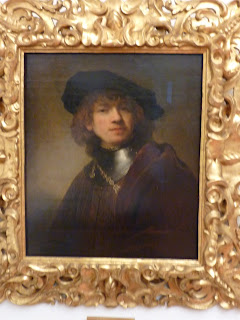 |
The bell that was rung to convene the uprisings |
 |
Fra Angelica's Crucifixion |
 |
Throughout, the cells are decorated with Fra Angelica frescoes, many of them very well-known masterpieces; here, his Annunciation |
 |
Fra Angelica's Linaioli Madonna (for the linen merchants), 1433, his first public work; much under the influence of Masaccio (whom we'll see a bit later) |
 |
According to our 1896 Michelin Guide, Savanrola's cell was the one with the Juda Kiss, above; the museum designated his room otherwise |
 |
Last Supper; note the guy on the lower right with the black halo: unusual treatment of Judas |
 |
Crucifixion |
 |
Some of Savanarola's personal effects; apparently he still was venerated here; the signage mentions his "martyrdom" |
 |
Famous portrait of the demagogue |
 |
Artsy-fartsy shot out the window, the Duomo |
 |
Torment |
 |
The Last Supper was always a popular treatment for, you guessed it, the refectory; this one, in what is now the gift-store, is by Ghirlandaio, one of three he did in Florence |
 |
Jesus seems to be saying "From now on, his limit is two"; note the guy sitting nearest does not have a halo; nor does the cat; I regard this as rather seriously bad news for cats |
 |
Of course I'd take any Fra Angelica fresco in my bed-chamber, but this one seems particularly appropriate |





































